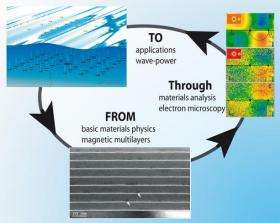Major step toward less energy loss in new electromagnetic materials

(PhysOrg.com) -- Researchers at Uppsala University have managed for the first time to measure magnetic properties in new materials quantitatively with the help of electron microscopy - with unparalleled precision. The secret behind the breakthrough is a successful elaboration of electron microscope technology. The findings, published in the scientific journal Physical Review Letters, means that the energy loss entailed in all electromagnetic materials can ultimately be minimized.
Apace with the miniaturization of electronic components, new methods are needed to analyze the properties of materials down to the atomic level. In 2006 a scientific article showed that it is possible to use a transmission electron microscope to study the magnetic properties of a material, using a technique called "Electron Magnetic Circular Dichroism," (EMCD). As different materials are combined, often in thin atomic monolayer films, exciting new magnetic properties are created. This is an interesting research field that is used in hard drives, for example. Today scientists are primarily studying magnetic properties with the aid of an extremely expensive synchrotron light source, whereas EMCD affords a cheaper and considerably more detailed study of the magnetic properties of each layer down to one nanometer.
Until now it has only been shown that EMCD works qualitatively. The Uppsala University researchers have further elaborated the technology to enable it to measure the magnetic forces of the sample quantitatively as well.
"This means we can put a number on the magnetic strength of the sample, which is key to understanding how various materials interact," says Klaus Leifer, professor of experimental physics at the Department of Engineering Sciences.
By combining practical experiments and theoretical calculations, the method of measuring the EMCD signal has now been optimized and the computer processing of the experimental data further developed. The article is the result of collaborative work involving researchers in materials theory, physical materials synthesis, and experimental physics.
These findings are important for our ability to analyze the magnetic properties of a material using equipment that is standard in most electron microscopy laboratories today.
"The technology will also enhance our knowledge of the energy losses that occur in magnetic components in generators and transformers," says Klaus Leifer.
More information: Read the article on the Physical Review Letters Web site.
Provided by Uppsala University





















